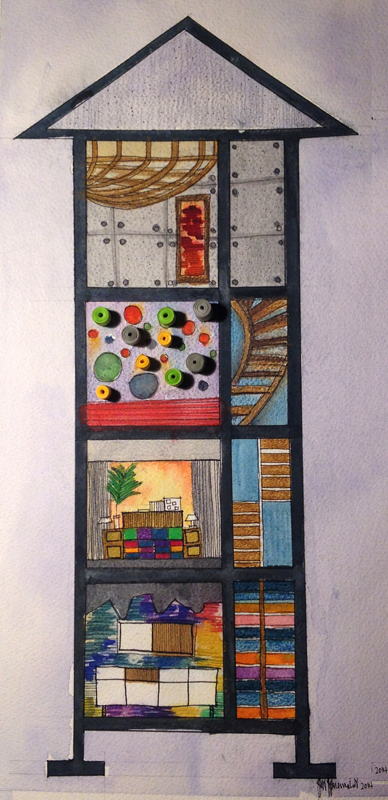On Sections
October 13, 2015
On Sections
Text and Art Work By Nikki Boncan- Buensalido
(As published in Business Mirror, Urban Monologues 2.0)
I have always had a fascination with sections. People on different floors do things simultaneously without knowing that they all exist at a certain point in time. In the field of architecture, sections are equally as important as elevations and for concept-driven projects, the sections are referenced even more. Sections depict some of the most intricate details that explain how to construct a structure. It is interesting to see how these drawings are detailed on paper and how the user’s lifestyle and habits change according to how these sections are designed.
I was at friend’s condo recently and was observing the habits of the condo-dwellers. As the sun sets and dusk turns into night, I observed that the building comes to life as lights turn on. It was enchanting to witness a static structure turn into a living organism once the lights turn on- as if revealing its internal organisms. Not to stalk or anything – but some units turned on their lights, others their television sets, others were in the kitchen preparing dinner and the other in the living room entertaining friends and or having family time together. It was just alluring to see how different people adapt and change their lifestyles based on how developers and their architects design these urban spaces. The units are all laid out the same save for a few changes with number of bedrooms and the like but as I sit and watch how each space is used and how each is decorated differently from each other, I realize how creative people can get sometimes even without them realizing it. They are able to customize the space according to their lifestyle. They are able to work around conditions and adjust to the parameters dictated by the units themselves.
The same is true with office spaces as I pass the Central Business District and the Fort Bonifacio Skyscrapers and as I observe people on the windows. The only difference is the usage and the function of the buildings. In office spaces, instead of couches, TV screens kitchens and bedrooms, desks piled with paper work, conference rooms or brain storming rooms fill each window. It is fascinating to see how even the lighting preferences differ to people. Some use warm white and some use daylight. They all have different minds of their own. I tried to imagine and put myself in various perspectives. I imagine myself in one floor and my entire line of sight of the space changes. In that particular instance, the going-ons in that particular space engulf my presence, you feel the tension, the stress, the business of the office but when I pull away and I change my perspective to that from a person in a distance, I am able to see offices on each floor and how they all function and differ from each other. You now observe people running to and fro, talking to each other, perhaps making business deals work, perhaps running after a deadline.

The Author’s Illustration of her thoughts as she tries to capture the images running around in her mind. Here, she tries to depict how people on each floor live separately without knowing that they all exist together at a certain point in time. These people are different from each other and have varied taste but share one thing without knowing it – they share the structure that they live or work in.
As we go about our busy days, it is sometimes just nice to look at things in different perspectives and different situations. Sometimes, insights from these musings are what give daily doses of wisdom. Looking at different perspectives make us realize what life is all about. There are always insights that we can extract from these experiences – we just have to be sensitive enough to take in and process these thoughts to make better people, heck better designers and creative individuals in the end. These are possible instances, thoughts and perspectives where we can draw sources of inspiration as we continually study people’s habits and lifestyles that we, as designers need to take into consideration when it comes to designing for communities that work.
